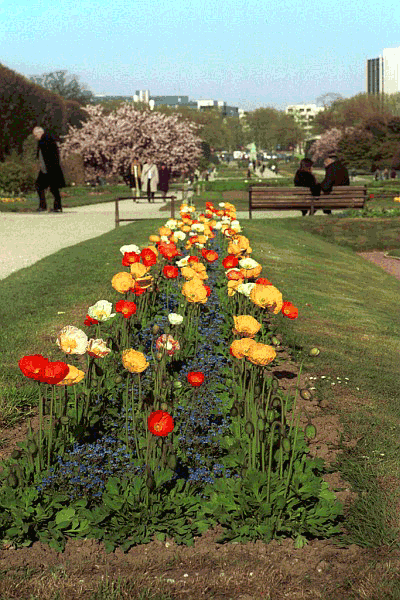Parks and gardens
Feel the need for a breath of fresh air?

Source:www.parisbalades.com
Below are some examples of renowned parks and gardens where you can stroll about, relax and have a rest. These open air spaces provide ideal spots for picnics or for letting your children run around freely.
It’s up to you!
Don’t hesitate to contact the Paris Tourism Office for further information on the parks and gardens of Paris.
Jardin des Tuileries

© Pariserve.com
In 1553 Catherine de Medici decided to open the park and to construct a castle there. She bought the Tuileries site and had an Italian style park landscaped there, with fountains, a cave, a greenhouse and a menagerie.
In the 16th century the jardin des Tuileries quickly became a fashionable place to take a walk. In the 17th century Colbert commissioned Le Nôtre to refurbish the park and to this day the park is laid out according to those designs.
Jardin des Plantes

© Paris Tourist
Office -
Photographe : Catherine Balet
The creation of the Jardin
des Plantes dates from 1626, under the reign of Louis XIII.
It was the work of two of the king’s doctors: Jean Héroard
and Guy de la Brosse. The intendant of the garden from 1739 to
1788, Buffon, enlarged and considerably enriched the garden with
the help of Daubenton. remonte à 1626, sous Louis XIII,
et fut l'oeuvre de deux médecins du Roi, Jean Héroard
et Guy de la Brosse. Buffon, intendant de 1739 à 1788,
agrandit et enrichit considérablement le jardin avec l'aide
de Daubenton.
The garden was conserved and designated the Museum
of Natural History, whereupon eminent naturalists such as Lacépède,
Cuvier, Becquerel and Lamarck contributed to the variety of its
fauna. As well as the botanic garden, one can also visit the menagerie,
which was created from the former royal menagerie.
The Floral Promenade

Source:www.parisbalades.com
(Cyclists can access the promenade from Avenue
Vivaldi or Rue de Picpus and continue to the Bois de Vincennes)
(open 08.00 - 21.00, 9.00 - 21.00 Saturdays and Sundays for overpass
and underpass sections) (architect: Philippe Mathieux, landscaper:
Jacques Vergely).
The promenade was established in 1988 along the
old railway line that had linked Bastille to Saint Maur until
1970. It has kept the original infrastructure: viaducts, tunnels,
ravines. Verdant and lined with little gardens, the walkway also
affords an uncommon view of the backs of buildings.
- Jardin Hector Malot (Rue Hector-Malot) is composed of two terraces decorated with canals, fountains, maple trees, flowers and plants… (Christo-Foroux workhop, 1995)
- Jardin de Reuilly (architect: Pierre Colboc
and Groupe Paysages, 1992)
It is inspired by the old sorting station, most notably in the
case of the children’s games. Around the big lawn thematic
gardens are arranged: an aquatic garden, a rose garden, etc.
Bois de Vincennes (métro Porte Dorée)

Source:
www.parisbalades.com
In the beginning of the 13th century, Philippe
August had a 12km wall built around the royal hunting ground at
Vincennes. Stags and does were then released to roam within the
walls.
Under Louis XV, the forest was transformed into a public promenade
and six gates were added to the wall to provide access to the
enclosure. In the 19th century, the park became a military training
ground and the woods were cleared to make way for barracks, manoeuvring
grounds and firing ranges.
In 1860, Napoleon III ceded the ground to the
city of Paris that it might be transformed into a symmetric park
like the Bois de Boulogne. Haussman commissioned Alphand to design
the park in the English style for which the emperor had a liking:
the grounds were reforested, lakes and ponds were created.
The Lac de Gravelle, fed by the waters of the Marne, serves as
a reservoir for the other lakes and streams that run across the
park. A racing course was installed, and little by little the
sporting areas grew. Two signposted pathways lead walkers through
the grounds.
Today, the
park boasts a zoo, a floral park, the Georges-Ville farm,
a Buddhist temple, a tropical garden (and the Institute of Agronomic
and Tropical Research), the Technical Centre for Tropical Forestry,
a horticultural school with an arboretum, the Cartoucherie de
Vincennes theatre and the Foire du Trône in the spring.
- Paris-city Partners :
- Music News
- Rock, Jazz & Blues CDs
- Learn French in Paris
- Learn French in France
- Paris Junior Programs
- Learn English in England
- Business English Courses
- Need a translation?
- For teachers of French
- French Exercise & Tests
- Directories
- English courses for Teens in UK
- Camps for Teens in England
- Language Courses Abroad
- English courses in England
- Learn a Language Abroad


